谈谈Java反射:从入门到实践,再到原理
反射是Java底层框架的灵魂技术,学习反射非常有必要,本文将从入门概念,到实践,再到原理讲解反射,希望对大家有帮助。
反射理解
官方解析
Oracle 官方对反射 的解释是:
Reflection is commonly used by programs which require the ability to examine or modify the runtime behavior of applications running in the Java virtual machine. This is a relatively advanced feature and should be used only by developers who have a strong grasp of the fundamentals of the language. With that caveat in mind, reflection is a powerful technique and can enable applications to perform operations which would otherwise be impossible. 复制代码
Java 的 反射机制 是指在运行状态中,对于任意一个类都能够知道这个类所有的属性和方法; 并且对于任意一个对象,都能够调用它的任意一个方法;这种动态获取信息以及动态调用对象方法的功能成为Java语言的反射机制。
白话理解
正射
万物有阴必有阳,有正必有反。既然有反射,就必有“正射”。
那么 正射 是什么呢?
我们在编写代码时,当需要使用到某一个类的时候,都会先了解这个类是做什么的。然后实例化这个类,接着用实例化好的对象进行操作,这就是正射。
Student student = new Student();
student.doHomework("数学");
复制代码
反射
反射就是,一开始并不知道我们要初始化的类对象是什么,自然也无法使用 new 关键字来创建对象了。
Class clazz = Class.forName("reflection.Student");
Method method = clazz.getMethod("doHomework", String.class);
Constructor constructor = clazz.getConstructor();
Object object = constructor.newInstance();
method.invoke(object, "语文");
复制代码
正射与反射对比
以上两段代码,执行效果是一样的,如图
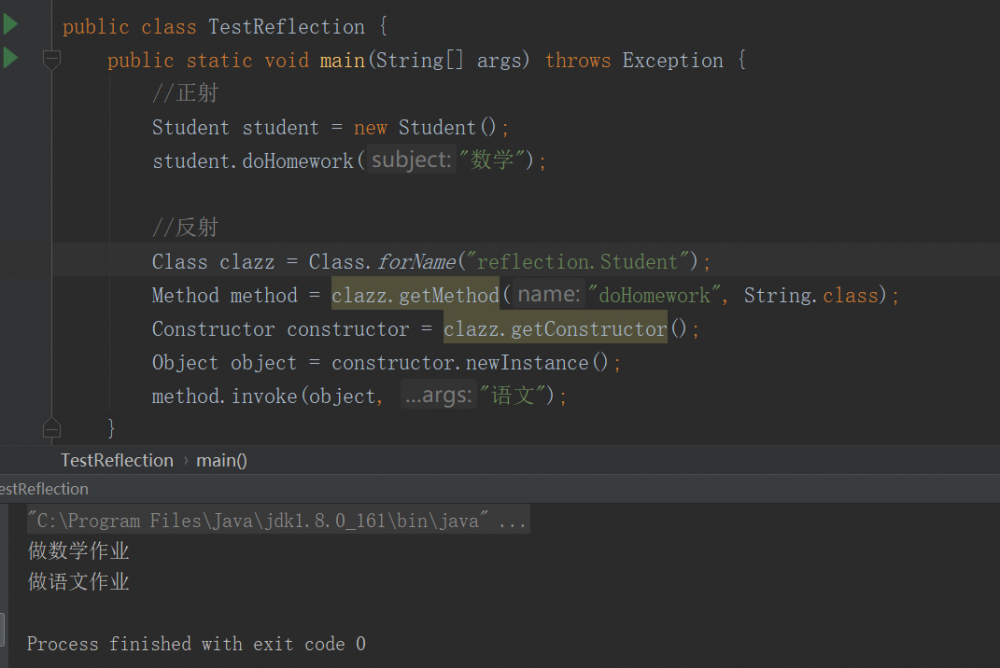
但是,其实现的过程还是有很大的差别的:
- 第一段代码在未运行前就已经知道了要运行的类是
Student; - 第二段代码则是到整个程序运行的时候,从字符串
reflection.Student,才知道要操作的类是Student。
结论
反射就是在运行时才知道要操作的类是什么,并且可以在运行时获取类的完整构造,并调用对应的方法。
Class 对象理解
要理解Class对象,我们先来了解一下 RTTI 吧。 RTTI(Run-Time Type Identification)运行时类型识别 ,其作用是在运行时识别一个对象的类型和类的信息。
Java是如何让我们在运行时识别对象和类的信息的?主要有两种方式: 一种是传统的 RRTI ,它假定我们在编译期已知道了所有类型。 另一种是反射机制,它允许我们在运行时发现和使用类的信息。
每个类都有一个Class对象,每当编译一个新类就产生一个Class对象(更恰当地说,是被保存在一个同名的.class文件中)。比如创建一个Student类,那么,JVM就会创建一个Student对应Class类的Class对象,该Class对象保存了Student类相关的类型信息。

Class类的对象作用是运行时提供或获得某个对象的类型信息
反射的基本使用
获取 Class 类对象
获取反射中的Class对象有三种方法。
第一种,使用 Class.forName 静态方法。
Class class1 = Class.forName("reflection.TestReflection");
复制代码
第二种,使用类的.class 方法
Class class2 = TestReflection.class; 复制代码
第三种,使用实例对象的 getClass() 方法。
TestReflection testReflection = new TestReflection(); Class class3 = testReflection.getClass(); 复制代码
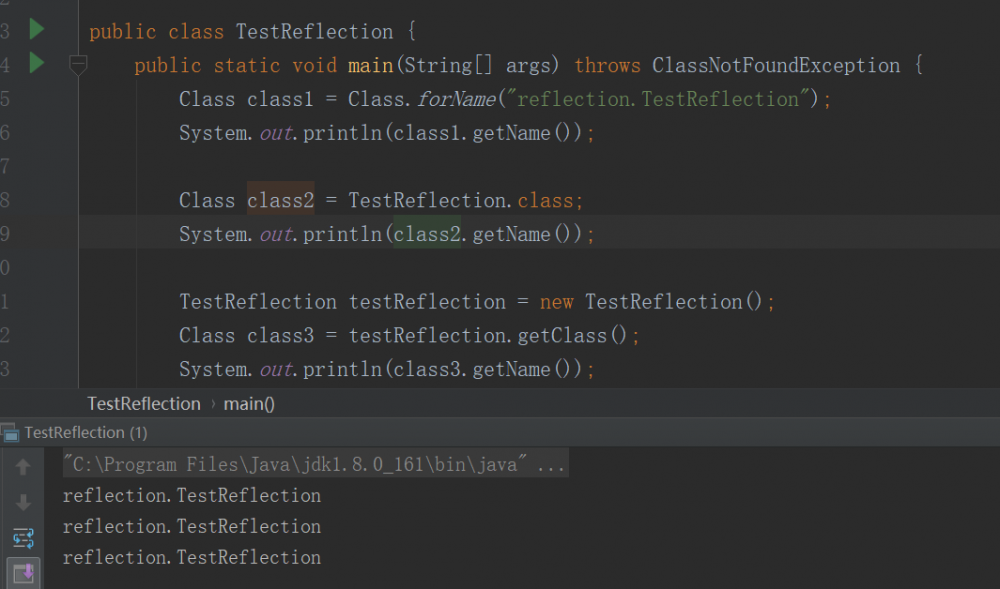
反射创造对象,获取方法,成员变量,构造器
本小节学习反射的基本API用法,如获取方法,成员变量等。
反射创造对象
通过反射创建类对象主要有两种方式:
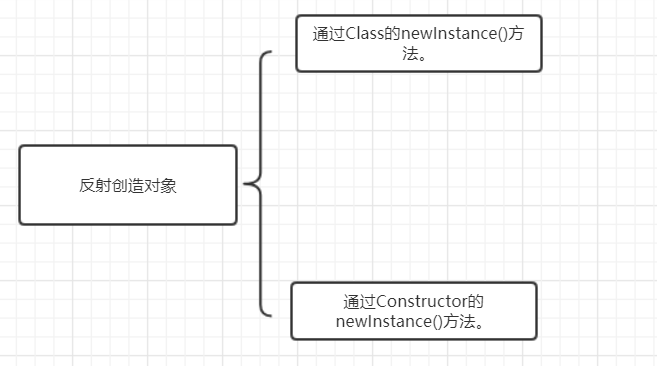
实例代码:
//方式一
Class class1 = Class.forName("reflection.Student");
Student student = (Student) class1.newInstance();
System.out.println(student);
//方式二
Constructor constructor = class1.getConstructor();
Student student1 = (Student) constructor.newInstance();
System.out.println(student1);
复制代码
运行结果:
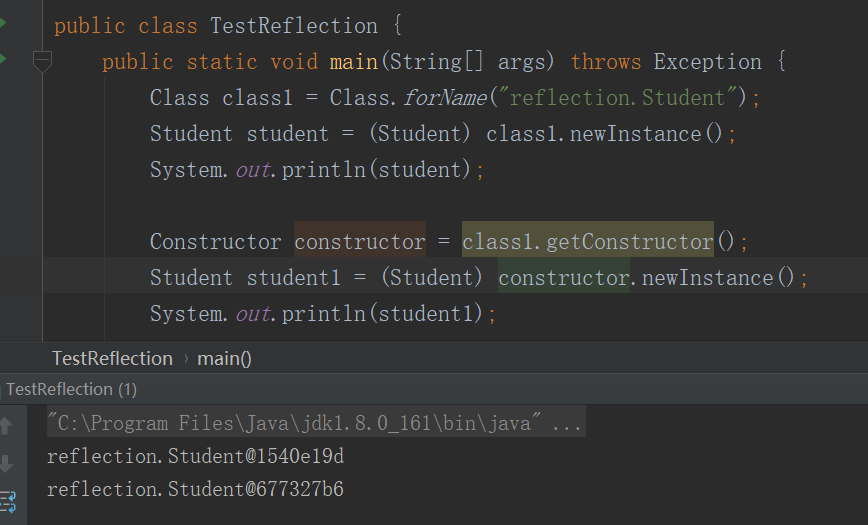
反射获取类的构造器

看一个例子吧:
Class class1 = Class.forName("reflection.Student");
Constructor[] constructors = class1.getDeclaredConstructors();
for (int i = 0; i < constructors.length; i++) {
System.out.println(constructors[i]);
}
复制代码
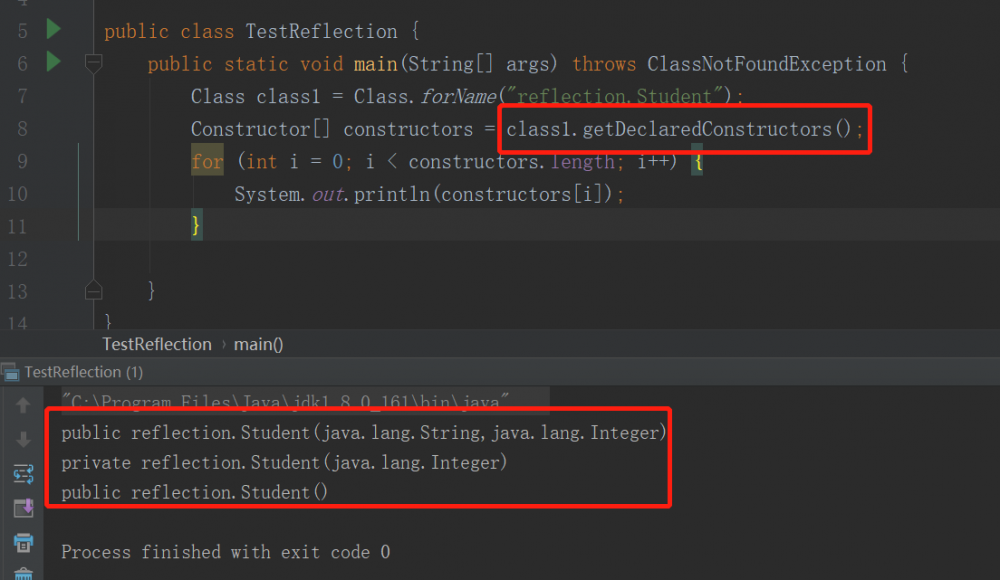
反射获取类的成员变量
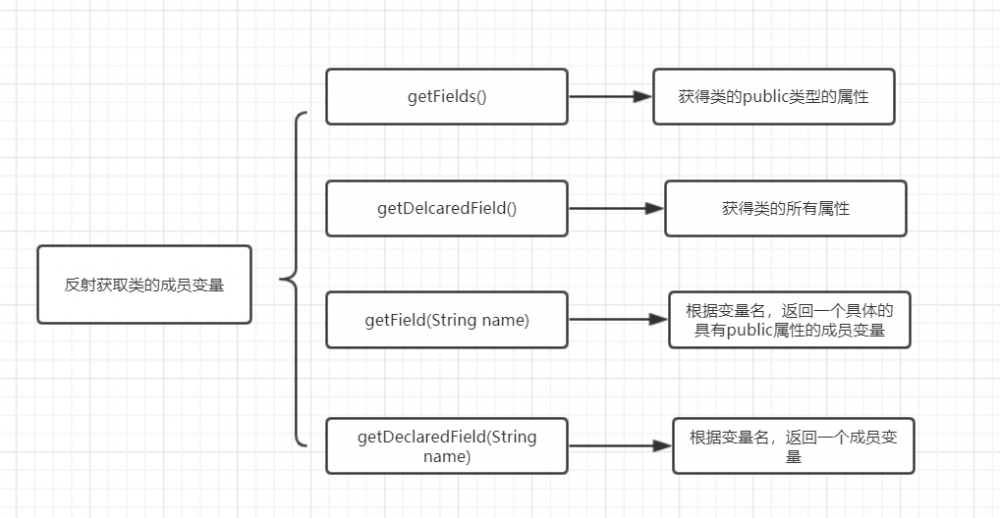
看demo:
// student 一个私有属性age,一个公有属性email
public class Student {
private Integer age;
public String email;
}
public class TestReflection {
public static void main(String[] args) throws ClassNotFoundException, NoSuchFieldException {
Class class1 = Class.forName("reflection.Student");
Field email = class1.getField("email");
System.out.println(email);
Field age = class1.getField("age");
System.out.println(age);
}
}
复制代码
运行结果:
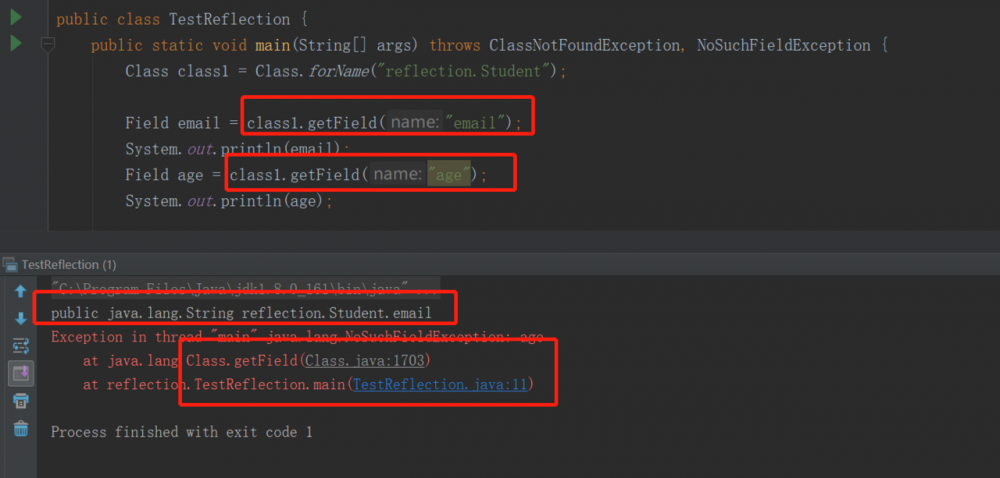
getField(String name) 根据参数变量名,返回一个具体的具有public属性的成员变量,如果该变量
不是public属性
,则报异常。
反射获取类的方法
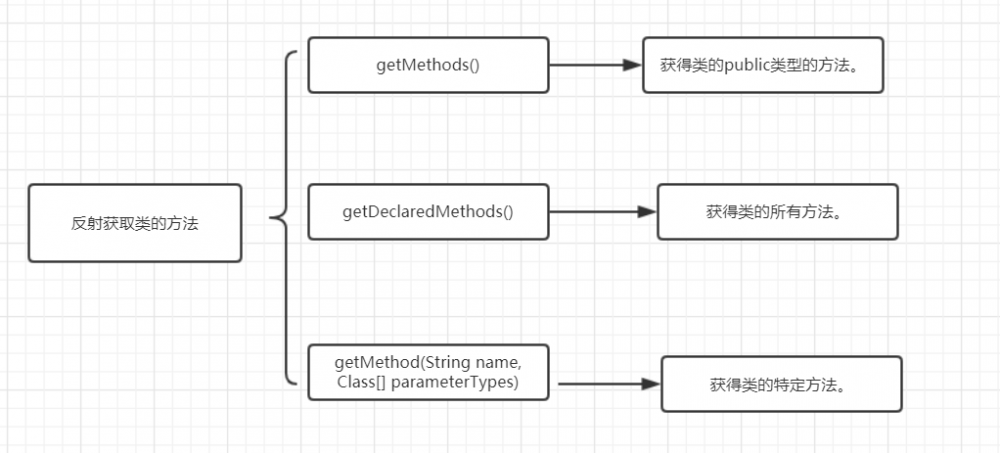
demo
public class Student {
private void testPrivateMethod() {
}
public void testPublicMethod() {
}
}
public class TestReflection {
public static void main(String[] args) throws ClassNotFoundException, NoSuchFieldException {
Class class1 = Class.forName("reflection.Student");
Method[] methods = class1.getMethods();
for (int i = 0; i < methods.length; i++) {
System.out.println(methods[i]);
}
}
}
复制代码
运行结果:
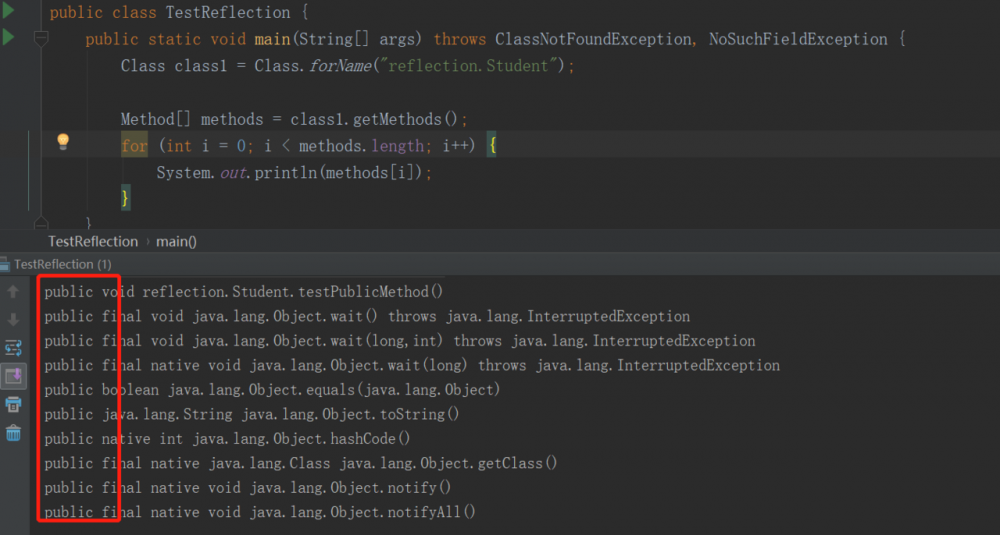
反射的实现原理
通过上一小节学习,我们已经知道反射的基本API用法了。接下来,跟着一个例子,学习反射方法的执行链路。
public class TestReflection {
public static void main(String[] args) throws Exception {
Class clazz = Class.forName("reflection.TestReflection");
Method method = clazz.getMethod("target", String.class);
method.invoke(null, "666");
}
public static void target(String str) {
//打印堆栈信息
new Exception("#" +str).printStackTrace();
System.out.println("invoke target method");
}
}
复制代码
堆栈信息反映出反射调用链路:
java.lang.Exception: #666 invoke target method at reflection.TestReflection.target(TestReflection.java:17) at sun.reflect.NativeMethodAccessorImpl.invoke0(Native Method) at sun.reflect.NativeMethodAccessorImpl.invoke(NativeMethodAccessorImpl.java:62) at sun.reflect.DelegatingMethodAccessorImpl.invoke(DelegatingMethodAccessorImpl.java:43) at java.lang.reflect.Method.invoke(Method.java:498) at reflection.TestReflection.main(TestReflection.java:11) 复制代码
invoke方法执行时序图
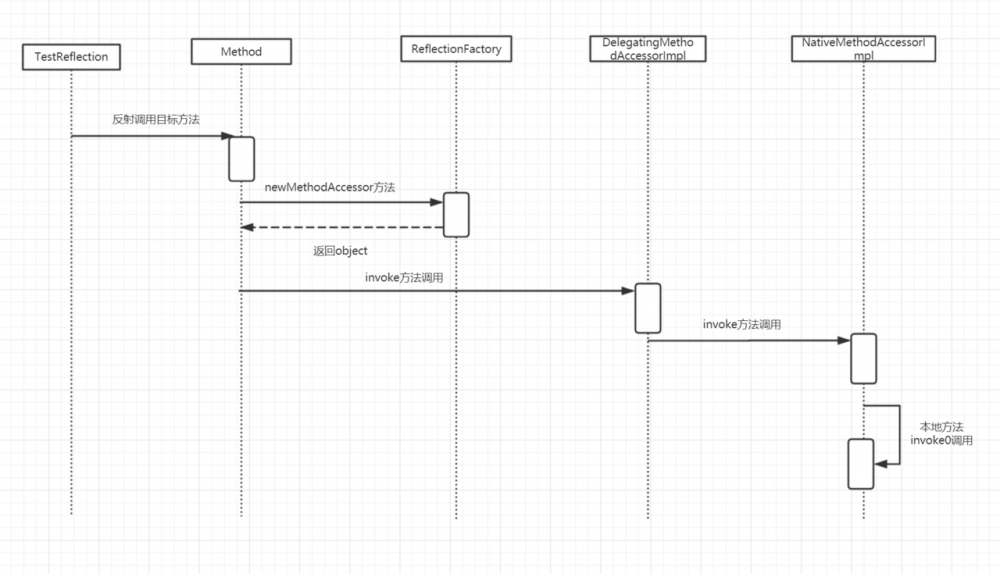
我们跟着反射链路去看一下源码,先看Method的invoke方法:
public Object invoke(Object obj, Object... args)
throws IllegalAccessException, IllegalArgumentException,
InvocationTargetException
{
//校验权限
if (!override) {
if (!Reflection.quickCheckMemberAccess(clazz, modifiers)) {
Class<?> caller = Reflection.getCallerClass();
checkAccess(caller, clazz, obj, modifiers);
}
}
MethodAccessor ma = methodAccessor; // read volatile
if (ma == null) {
ma = acquireMethodAccessor(); //获取MethodAccessor
}
//返回MethodAccessor.invoke
return ma.invoke(obj, args);
}
复制代码
由上可知道,Method 的 invoke 方法,其实是返回接口MethodAccessor的invoke方法。MethodAccessor接口有三个实现类,到底调用的是哪个类的 invoke 方法呢?
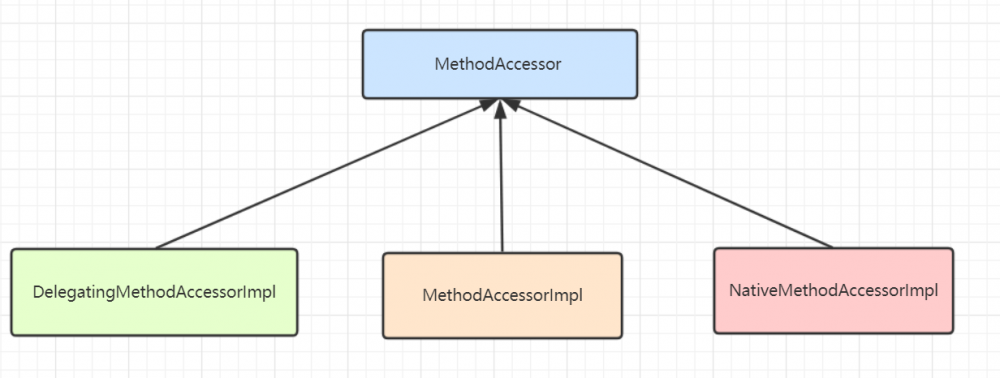
进入acquireMethodAccessor方法,可以看到MethodAccessor由ReflectionFactory 的 newMethodAccessor方法决定。
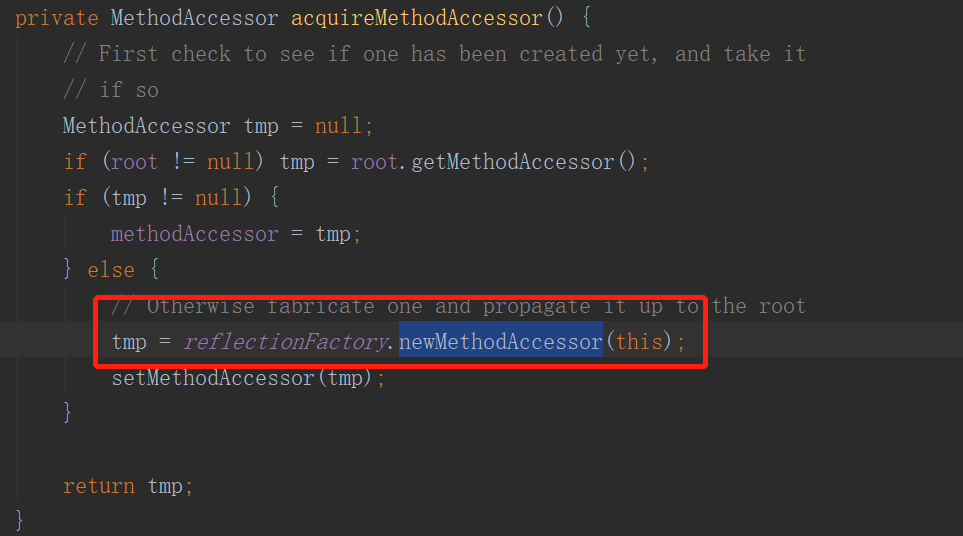
再进ReflectionFactory的newMethodAccessor方法,我们可以看到返回的是DelegatingMethodAccessorImpl对象,也就是说调用的是它的invoke方法。

再看DelegatingMethodAccessorImpl的invoke方法
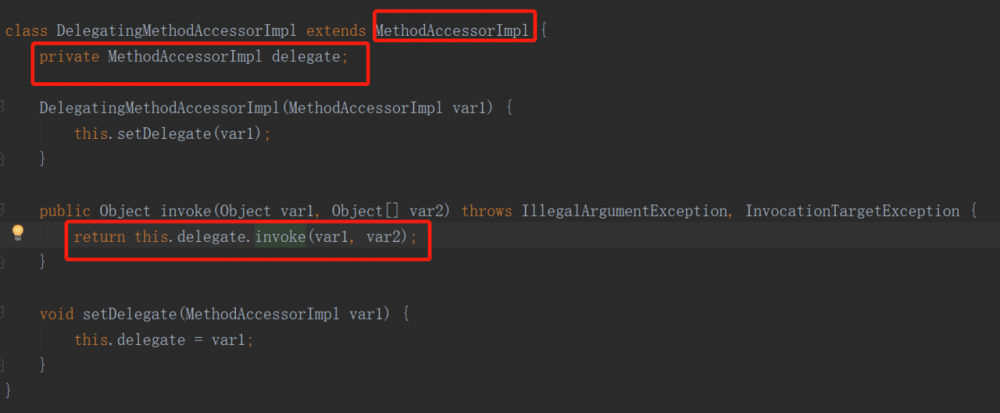
DelegatingMethodAccessorImpl的invoke方法返回的是MethodAccessorImpl的invoke方法,而MethodAccessorImpl的invoke方法,由它的子类NativeMethodAccessorImpl重写,这时候返回的是本地方法invoke0,如下
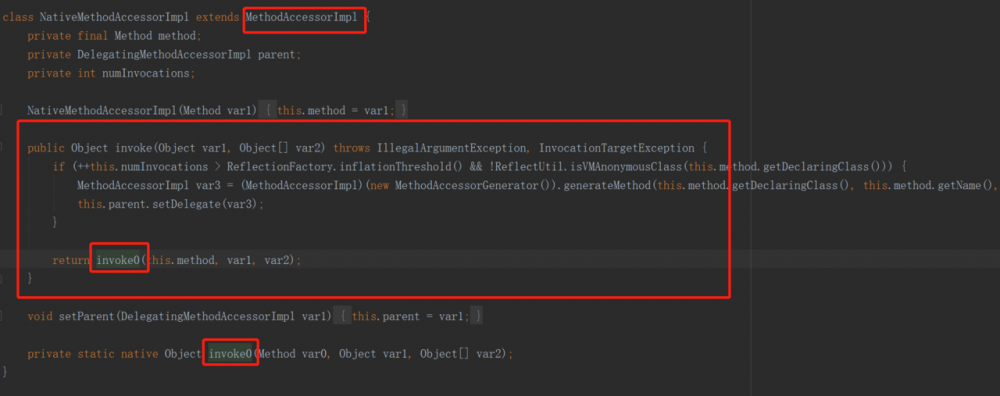
因此,Method的invoke方法,是由本地方法invoke0决定的,再底层就是c++相关了,有兴趣的朋友可以继续往下研究。
反射的一些应用以及问题
反射应用
反射是Java框架的灵魂技术,很多框架都使用了反射技术,如spring,Mybatis,Hibernate等。
JDBC 的数据库的连接
在JDBC连接数据库中,一般包括 加载驱动,获得数据库连接 等步骤。而加载驱动,就是引入相关Jar包后,通过 Class.forName() 即反射技术,加载数据库的驱动程序。
Spring 框架的使用
Spring 通过 XML 配置模式装载 Bean,也是反射的一个典型例子。
装载过程:
- 将程序内XML 配置文件加载入内存中
- Java类解析xml里面的内容,得到相关字节码信息
- 使用反射机制,得到Class实例
- 动态配置实例的属性,使用
这样做当然是有好处的:
不用每次都去new实例了,并且可以修改配置文件,比较灵活。
反射存在的问题
性能问题
java反射的性能并不好,原因主要是编译器没法对反射相关的代码做优化。 有兴趣的朋友,可以看一下这个文章 java-reflection-why-is-it-so-slow
安全问题
我们知道单例模式的设计过程中,会强调 将构造器设计为私有 ,因为这样可以防止从外部构造对象。但是反射可以获取类中的域、方法、构造器, 修改访问权限 。所以这样并不一定是安全的。
看个例子吧,通过反射使用私有构造器实例化。
public class Student {
private String name;
private Student(String name) {
System.out.println("我是私有构造器,我被实例化了");
this.name = name;
}
public void doHomework(String subject) {
System.out.println("我的名字是" + name);
System.out.println("我在做"+subject+"作业");
}
}
public class TestReflection {
public static void main(String[] args) throws Exception {
Class clazz = Class.forName("reflection.Student");
// 获取私有构造方法对象
Constructor constructor = clazz.getDeclaredConstructor(String.class);
// true指示反射的对象在使用时应该取消Java语言访问检查。
constructor.setAccessible(true);
Student student = (Student) constructor.newInstance("jay@huaxiao");
student.doHomework("数学");
}
}
复制代码
运行结果:
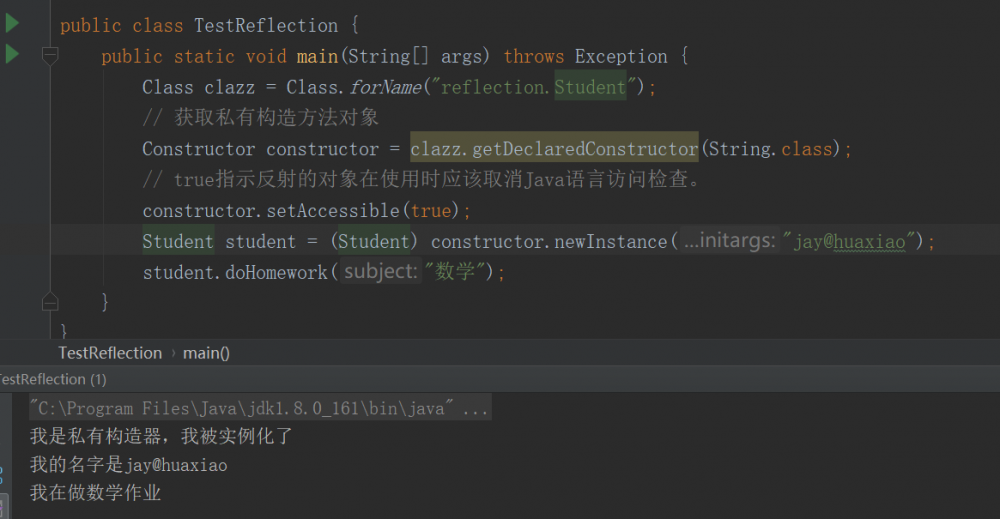
。如果一个程序对安全性有强制要求,最好不要使用反射啦。











![[HBLOG]公众号](https://www.liuhaihua.cn/img/qrcode_gzh.jpg)

